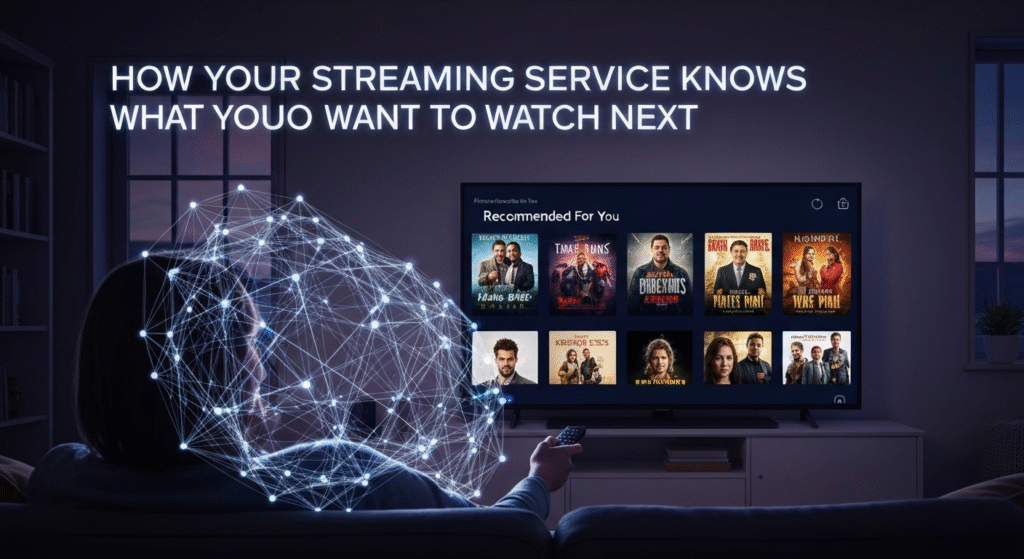Ever finish a show and feel a little lost, only for your streaming service to suggest the perfect next binge-watch? It feels like magic, almost as if it’s reading your mind. You might wonder how platforms like Netflix, YouTube, or Spotify are so good at predicting what you’ll love. The truth is, it’s not magic; it’s a powerful and fascinating type of artificial intelligence known as a recommendation engine. These smart systems are the hidden force shaping your digital entertainment, and understanding how they work can demystify the entire experience.
My name is Zain Mhd, and for the past five years, I’ve been immersed in the world of artificial intelligence. I’ve spent countless hours exploring how these complex systems function, not just in theory but in our daily lives. My passion lies in taking these intricate topics and breaking them down into clear, understandable explanations for curious readers. The AI behind your streaming queue is one of the most practical examples of this technology at work. In this article, we’ll pull back the curtain on the methods these platforms use to become your personal movie and music curators.
What Are Recommendation Engines Anyway?

At its core, a recommendation engine is a piece of software that filters information and predicts what a user might want. Think of it as a super-powered digital assistant whose only job is to sift through millions of options—movies, songs, articles, or products—to find the few that you’ll personally enjoy. The main goal is to keep you engaged, happy, and subscribed by making your experience feel tailored just for you.
To do this, these systems collect and analyze a massive amount of data. Every action you take on a platform is a signal, a clue about your preferences. This includes:
- What you watch, listen to, or buy.
- What you rate highly (or give a thumbs-down to).
- How long you watch something before clicking away.
- What you add to your watchlist.
- The time of day you usually watch content.
- The devices you use.
This data feeds the AI, allowing it to build a surprisingly detailed “taste profile” for you. It then uses this profile to make its highly-educated guesses. While the exact algorithms are complex and top-secret, they generally rely on two primary methods: collaborative filtering and content-based filtering. Most modern services use a combination of both, but understanding them separately is the key to grasping the whole picture.
The Two Main Flavors of AI Recommendations
Let’s break down the two foundational approaches that power these engines. Imagine two different types of movie buffs giving you suggestions. One recommends movies based on what other people with similar tastes enjoy. The other recommends movies based on the specific qualities of the films you already love. This is the basic difference between collaborative and content-based filtering.
Here is a quick comparison of the two core ideas:
| Feature | Collaborative Filtering | Content-Based Filtering |
| Core Idea | “People who liked what you like also liked this.” | “You liked this specific thing, so you’ll like other things with similar features.” |
| Data Source | User behavior and interactions (ratings, views). | Attributes of the items (genre, actors, keywords). |
| Key Strength | Can create diverse and unexpected recommendations. | Effective for recommending niche items and new content. |
| Main Weakness | Struggles with new users and items (the “cold start” problem). | Can create a “filter bubble” by only suggesting similar content. |
Now, let’s dive into each of these methods to see how they actually work in the real world.
Collaborative Filtering: Learning from the Crowd

Collaborative filtering is the most common and powerful method behind recommendations. The central idea is simple: it finds people with tastes similar to yours and then suggests things they liked that you haven’t seen yet. It doesn’t need to know anything about the movie itself—only that a group of like-minded people enjoyed it. It’s essentially word-of-mouth on a massive, automated scale.
How It Works: Finding Your Digital Doppelgänger
This method works by building a giant matrix of user-item interactions. Let’s break down the process into a few simple steps.
- You Provide Data: You watch shows, rate movies with a thumbs-up, and add titles to your watchlist. Every interaction is recorded.
- The AI Builds Your Profile: The system creates a unique taste profile for you based on your history. This profile is essentially a list of items and your feelings about them.
- It Finds Your “Neighbors”: The AI then scours its database of millions of other users to find people whose profiles are most similar to yours. These users are your “neighbors” or your digital doppelgängers.
- It Recommends Their Favorites: Finally, the system looks at the top-rated shows and movies that your neighbors loved but that you haven’t watched yet. These items become your top recommendations.
A Real-World Example in Action
Let’s say you’ve spent the last month watching and loving three specific shows: Stranger Things (a sci-fi horror series), Black Mirror (a dark sci-fi anthology), and The Witcher (a fantasy series). The recommendation engine identifies millions of other users who also rated these three shows highly.
The AI then analyzes the viewing habits of this “taste cluster.” It discovers that a significant percentage of these users also watched and gave five stars to a German sci-fi thriller called Dark. Since you fit the profile perfectly but haven’t seen Dark, the system flags it as a high-probability match for you. The next time you log in, Dark appears prominently in your “Top Picks for You” row.
Pros and Cons of Collaborative Filtering
This crowd-sourced approach is incredibly effective, but it isn’t perfect. It has distinct advantages and disadvantages that platforms have to manage.
| Pros | Cons |
| Serendipity: It can recommend items that are very different from what you usually watch, leading to new discoveries. | The Cold Start Problem: It doesn’t know what to recommend to a brand-new user because there’s no data. |
| No Content Analysis Needed: The system doesn’t need to understand genre, plot, or tone. It only needs user ratings. | Popularity Bias: It tends to recommend already popular items, making it harder for new or niche titles to get seen. |
| Self-Improving: The more users and interactions it gets, the smarter and more accurate the recommendations become. | Data Sparsity: It struggles with items that have very few ratings, as it’s hard to find user patterns. |
Content-Based Filtering: It’s All in the Details
Where collaborative filtering focuses on user behavior, content-based filtering focuses on the items themselves. The core idea here is: “If you like one thing, you’ll probably like another thing with similar attributes.” This method analyzes the content you’ve enjoyed and recommends other content that shares the same properties.
Breaking Down the Content: The Power of Tags
For content-based filtering to work, the AI needs to understand what each piece of content is about. It does this by assigning a huge number of descriptive tags or attributes to every movie, show, or song in its library. For a movie, these tags might include:
- Genre: Sci-Fi, Comedy, Romance, Thriller
- Sub-Genre: Dystopian Sci-Fi, Romantic Comedy, Psychological Thriller
- Actors & Director: Tom Cruise, Christopher Nolan
- Keywords: Time travel, aliens, high school romance, political conspiracy
- Tone: Witty, dark, inspiring, suspenseful, emotional
- Setting: New York City, outer space, 1980s
Netflix, for example, is famous for its hyper-specific tags, which can range from “Critically-Acclaimed Visually-Striking Foreign Dramas” to “Witty TV Comedies.” This detailed tagging system is the fuel for its content-based engine. A study from the University of California, Berkeley highlights how this granular data helps create highly personalized user experiences.
A Real-World Example in Action
Imagine you just finished watching The Dark Knight. The system logs this and analyzes its tags: “Action,” “Superhero,” “Christopher Nolan,” “Christian Bale,” “Dark,” “Gritty,” “Psychological Thriller.”
The AI then builds a profile for you that indicates a strong preference for these attributes. When it’s time to recommend something new, it scans its entire catalog for other movies that share these tags. It might recommend Batman Begins (same director, actor, and theme), Inception (same director and tone), or The Prestige (same director, actor, and a psychological element). The recommendations are based entirely on the characteristics of the content, not on what other users have watched.
Pros and Cons of Content-Based Filtering
This approach is excellent for certain scenarios but can also limit a user’s exposure to new types of content if not used carefully.
| Pros | Cons |
| Handles New Items: As long as a new movie is tagged properly, it can be recommended immediately without needing any user ratings. | Filter Bubble: It can trap you in a “bubble” of similar content, making it hard to discover new genres or styles. |
| User Independence: It doesn’t need data from other users to make a recommendation for you. | Limited by Tags: The quality of recommendations depends entirely on how well the content is tagged. Subjective qualities like “chemistry” are hard to define. |
| Transparency: The reasons for a recommendation are clear (e.g., “Because you watched The Dark Knight“). | Overspecialization: If you watch one documentary about penguins, it might assume you only want to see penguin documentaries. |
The Hybrid Approach: The Best of Both Worlds
By now, you’ve probably realized that neither system is perfect on its own. Collaborative filtering can be generic, and content-based filtering can be too narrow. That’s why virtually every modern streaming service uses a hybrid model, combining the strengths of both methods to create a more powerful and accurate recommendation engine.
How a Hybrid System Works
A hybrid system uses the two approaches to complement each other and cover each other’s weaknesses. For instance, it might use content-based filtering to solve the “cold start” problem. When you first sign up, it asks you to pick a few genres or movies you like. This gives the content-based system enough data to make initial recommendations.
Once you start watching and rating content, the collaborative filtering model kicks in. It begins to find your taste-neighbors and refines the suggestions based on their behavior. The two systems work together, often in a weighted system where one model might have more influence depending on the situation.
Here’s a practical example:
- The system knows you like sci-fi movies (content-based).
- It also knows from your ratings that you prefer shows with witty dialogue and strong female leads (content-based).
- It then looks for other users who also like sci-fi with those specific traits (collaborative).
- It sees that this group of users overwhelmingly loved a show called Firefly.
- Even though Firefly is a “space western” and very different from the last hard sci-fi movie you watched, the hybrid system confidently recommends it because it matches both your content preferences and the behavior of your digital twins.
This layered approach gets rid of the filter bubble while still feeling incredibly personal. It can introduce you to new things (a strength of collaborative) that are still very likely to be in your wheelhouse (a strength of content-based).
Beyond the Basics: Other Signals the AI Watches
The recommendation process doesn’t stop with just what you watch. Streaming services collect dozens of other “implicit signals” to fine-tune their suggestions even further. These can include:
- Watch Time: Did you finish the whole movie, or did you abandon it after 15 minutes? A completed view is a strong positive signal.
- Time of Day: It might learn you prefer light comedies during the day and intense dramas at night.
- Pauses and Rewinds: Did you rewind a specific scene? This signals high engagement.
- Thumbnail Art: Which movie posters do you click on? The artwork itself is part of the recommendation process. The service may even show different thumbnails for the same movie to different users to see which one performs best.
- Device: You might get recommendations for short-form content on your phone and feature-length films on your smart TV.
All these tiny data points are fed back into the algorithm, constantly refining its understanding of you. It’s a never-ending loop of data collection and prediction, all designed to answer one question: what should you watch next?
Frequently Asked Questions
1. Do streaming services listen to my conversations through my mic?
No, this is a common myth. Recommendation engines do not need to listen to your conversations. They can build an incredibly accurate profile of your interests just by analyzing your on-platform behavior, such as your clicks, watch history, and search queries. The data you provide willingly is more than enough.
2. Why do I get bad recommendations sometimes?
This can happen for a few reasons. If you share your account with family or friends, their viewing habits can confuse the algorithm. Your tastes might also change over time, and it can take the system a while to catch up. Sometimes, it just doesn’t have enough data on a specific niche to make a good prediction.
3. Can I reset my recommendation profile?
Yes, most services allow you to do this. You can typically go into your account settings and delete your viewing history. This will effectively reset the algorithm, and it will start learning your preferences from scratch again. Creating a separate profile for each user in a household is the best way to keep recommendations accurate.
4. Is this technology only used for movies and shows?
Not at all. Recommendation engines are everywhere. They’re used by Amazon to suggest products, Spotify to create your Discover Weekly playlist, YouTube to line up the next video, and even news websites to show you articles you might be interested in.
Conclusion
The eerily accurate recommendations from your favorite streaming service aren’t a sign that someone is watching you; they’re the product of sophisticated and well-designed AI systems. By combining collaborative filtering (the wisdom of the crowd) with content-based filtering (the details of the content), these platforms can predict your tastes with remarkable precision. They learn from every click, every view, and every rating to build a dynamic profile that evolves with you.
So, the next time you discover your new favorite show because it was sitting in your “Recommended for You” row, you’ll know exactly what happened. It wasn’t magic—it was a complex dance of data, algorithms, and the collective taste of millions of people, all working together to find the perfect thing for you to watch next.


